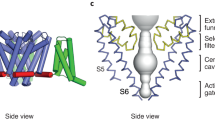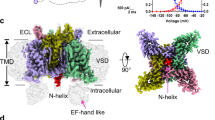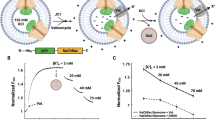Abstract
A voltage- and time-dependent conductance for sodium ions is responsible for the generation of impulses in most nerve and muscle cells1. Changes in the sodium conductance are produced by the opening and closing of many discrete transmembrane channels2. We present here the first report of electrical recordings from voltage-dependent sodium channels incorporated into planar lipid bilayers. In bilayers with many channels, batrachotoxin3 (BTX) induced a steady-state sodium current that was blocked by saxitoxin4 (STX) at nanomolar concentrations. All channels appeared in the bilayer with their STX blocking sites facing the side of vesicle addition, allowing us to define that as the extracellular side. Current fluctuations due to the opening and closing of single BTX-activated sodium channels were voltage-dependent (unit conductance, 30 pS in 0.5 M NaCl): the channels closed at large hyperpolarizing potentials. Slower fluctuations of the same amplitude, due to the blocking and unblocking of individual channels, were seen after addition of STX. Block of the sodium channels by STX was voltage-dependent, with hyperpolarizing potentials favouring block. The voltage-dependent gating, ionic selectivity and neurotoxin sensitivity suggest that these are the channels that normally underlie the sodium conductance change during the nerve impulse.
This is a preview of subscription content, access via your institution
Access options
Subscribe to this journal
Receive 51 print issues and online access
$199.00 per year
only $3.90 per issue
Buy this article
- Purchase on Springer Link
- Instant access to full article PDF
Prices may be subject to local taxes which are calculated during checkout
Similar content being viewed by others
References
Hodgkin, A. L. & Huxley, A. F. J. Physiol., Lond. 116, 497–506 (1952).
Sigworth, F. J. & Neher, E. Nature 287, 447–449 (1980).
Albuquerque, E. X. & Daly, J. in Receptors and Recognition Ser. B, Vol. 1 (ed. Cuatrecasas, P.) 297–338 (Chapman & Hall, London, 1976).
Narahashi, T. Physiol. Rev. 54, 813–866 (1974).
Mueller, P., Rudin, D. O., Tien, H. T. & Wescott, W. C. J. phys. Chem. 67, 534–535 (1963).
Krueger, B. K., Ratzlaff, R. W., Strichartz, G. R. & Blaustein, M. P. J. Membrane Biol. 50, 287–310 (1979).
Miller, C. J. Membrane Biol. 40, 1–23 (1978).
Miller, C. & Racker, E. J. Membrane Biol. 30, 283–300 (1976).
Cohen, F. S., Zimmerberg, J. & Finkelstein, A. J. gen. Physiol. 75, 251–270 (1980).
Khodorov, B. I. in Membrane Transport Processes Vol. 2 (eds Tosteson, D. C., Ovchinnikov, Y. A. & Latorre, R.) 153–174 (Raven, New York, 1978).
Huang, L.-Y. M., Moran, N. & Ehrenstein, G. Proc. natn. Acad. Sci. U.S.A. 79, 2082–2085 (1982).
Wagner, H.-H. & Ulbricht, W. Pflüger's Arch. ges. Physiol. 359, 297–315 (1975).
Krueger, B. K. & Blaustein, M. P. J. gen. Physiol. 76, 287–313 (1980).
Tamkun, M. M. & Catterall, W. A. Molec. Pharmac. 19, 78–86 (1981).
Ritchie, J. M. & Rogart, R. B. Rev. Physiol. Biochem. Pharmac. 79, 1–50 (1977).
Baer, M., Best, P. M. & Reuter, H. Nature 263, 344–345 (1976).
Cohen, I. S. & Strichartz, G. R. Biophys. J. 17, 275–279 (1977).
Colatsky, T. J. & Gadsby, D. C. J. Physiol., Lond. 306, 20P (1980).
Cohen, C. J., Bean, B. P., Colatsky, T. J. & Tsien, R. W. J. gen. Physiol. 78, 383–411 (1981).
Huang, L.-Y. M., Catterall, W. A. & Ehrenstein, G. J. gen. Physiol. 73, 839–854 (1979).
Frelin, C., Vigne, P. & Lazdunski, M. Eur. J. Biochem. 119, 437–442 (1981).
Hille, B. J. gen. Physiol. 59, 637–658 (1972).
Ebert, G. A. & Goldman, L. J. gen. Physiol. 68, 327–340 (1976).
Begenisich, T. B. & Cahalan, M. D. J. Physiol., Lond. 307, 217–242 (1980).
Patlak, J. & Horn, R. J. gen. Physiol. 79, 333–351 (1982).
Quandt, F. N. & Narahashi, T. Proc. natn. Acad. Sci. U.S.A. 79, 6732–6736 (1982).
Hille, B. J. gen. Physiol. 66, 535–560 (1975).
Author information
Authors and Affiliations
Rights and permissions
About this article
Cite this article
Krueger, B., Worley, J. & French, R. Single sodium channels from rat brain incorporated into planar lipid bilayer membranes. Nature 303, 172–175 (1983). https://doi.org/10.1038/303172a0
Received:
Accepted:
Issue Date:
DOI: https://doi.org/10.1038/303172a0
This article is cited by
-
Effects of veratridine and its derivatives on the Na-conducting channels in Helix neurons
Acta Biologica Hungarica (1999)
-
Modification of cloned brain Na+ channels by batrachotoxin
Pflügers Archiv European Journal of Physiology (1994)
-
Gating properties of cardiac Na+ channels in cell-free conditions
The Journal of Membrane Biology (1991)
-
Anion channels from rat brain synaptosomal membranes incorporated into planar bilayers
The Journal of Membrane Biology (1991)
-
Inactivation modifiers of Na+ currents and the gating of rat brain Na+ channels in planar lipid membranes
Pfl�gers Archiv European Journal of Physiology (1991)
Comments
By submitting a comment you agree to abide by our Terms and Community Guidelines. If you find something abusive or that does not comply with our terms or guidelines please flag it as inappropriate.



